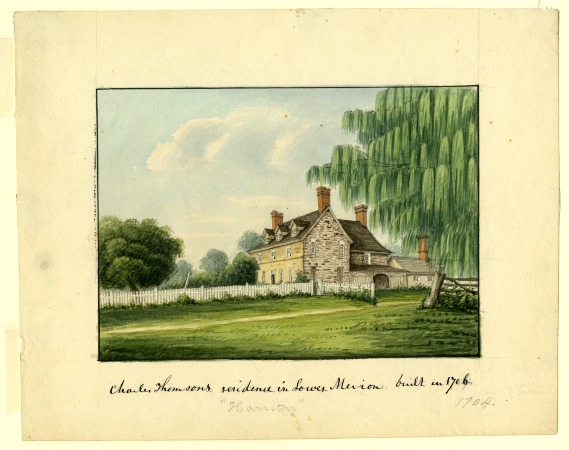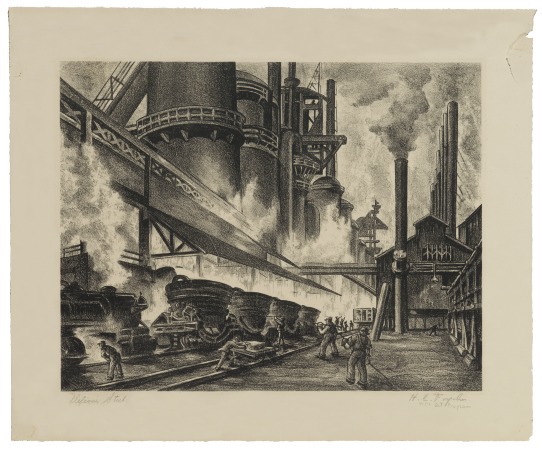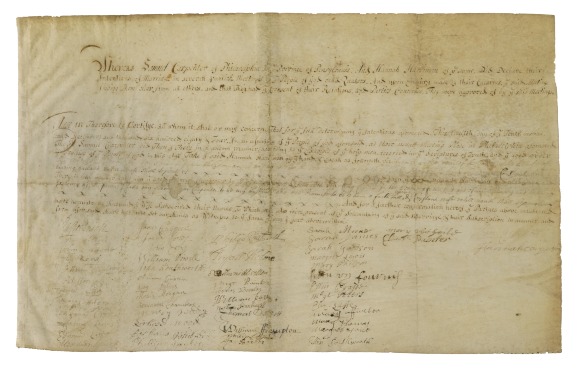Since starting at HSP in July as the new Rights and Reproductions Associate, I’ve handled lots of orders for digital reproductions of HSP materials and permission to distribute these materials in books, exhibitions, and other media. Processing R&R orders provides a great front row seat to HSP’s unique and diverse materials, not to mention the cool ways in which patrons are using our historical artifacts. While some materials are perennial favorites with patrons (Francis Place’s chalk portrait of William Penn is especially popular among textbook publishers), here’s a snapshot of MY favorite (and sometimes less well-known) R&R materials from the past two months:
 Not long after I began working at HSP, I received a request from Christie’s New York for a copy of a watercolor of Harriton House by William L. Breton. Built in 1704 by a Welsh Quaker, Harriton is located in Lower Merion and is best known as the home of Charles Thomson, “the Sam Adams of Philadelphia.” A Philadelphia merchant, Thomson became the first and only Secretary to the Continental Congresses and, in April 1789, traveled to Mount Vernon to inform George Washington that he had been elected the first President of the United States. Over 200 years later, a carved mahogany side chair belonging to Charles Thomson was featured in Christie’s September auction of American furniture, folk art, and decorative arts and the watercolor of Harriton House was used as an illustration in the auction catalog.
Not long after I began working at HSP, I received a request from Christie’s New York for a copy of a watercolor of Harriton House by William L. Breton. Built in 1704 by a Welsh Quaker, Harriton is located in Lower Merion and is best known as the home of Charles Thomson, “the Sam Adams of Philadelphia.” A Philadelphia merchant, Thomson became the first and only Secretary to the Continental Congresses and, in April 1789, traveled to Mount Vernon to inform George Washington that he had been elected the first President of the United States. Over 200 years later, a carved mahogany side chair belonging to Charles Thomson was featured in Christie’s September auction of American furniture, folk art, and decorative arts and the watercolor of Harriton House was used as an illustration in the auction catalog.
The Historical Society of Pennsylvania is perhaps best known for its colonial and early American history holdings, but we also have many collections of compelling twentieth-century materials. One of my favorites is the Work Projects Administration posters collection, which includes over 900 examples of works by Federal Art Project artists from the 1940s. While the Work Projects Administration was a federal program, it spawned many state and local subsidiaries, among them the Pennsylvania Art Program. Accordingly, while the subjects and styles of the artworks in the poster collection are diverse, many are also specific to Philadelphia and feature such local landmarks as the Philadelphia Zoo and the Philadelphia Museum of Art. The color and style of these woodblock prints notably contrasts with the charcoal shades of more well-known WPA artworks like Horatio Forjohn’s “Defense Steel,” which will be published in a forthcoming volume on industrial art.
Project artists from the 1940s. While the Work Projects Administration was a federal program, it spawned many state and local subsidiaries, among them the Pennsylvania Art Program. Accordingly, while the subjects and styles of the artworks in the poster collection are diverse, many are also specific to Philadelphia and feature such local landmarks as the Philadelphia Zoo and the Philadelphia Museum of Art. The color and style of these woodblock prints notably contrasts with the charcoal shades of more well-known WPA artworks like Horatio Forjohn’s “Defense Steel,” which will be published in a forthcoming volume on industrial art.
 n past and present that make working at HSP so rewarding and make R&R a great opportunity to share our collections with patrons far and wide.
n past and present that make working at HSP so rewarding and make R&R a great opportunity to share our collections with patrons far and wide.
